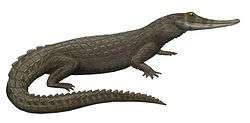Goniopholididae
| Goniopholidids Temporal range: 196–66 Ma | |
|---|---|
 | |
| Anteophthalmosuchus fossil, Musee d'Histoire Naturelle, Brussels | |
| Scientific classification | |
| Kingdom: | Animalia |
| Phylum: | Chordata |
| Class: | Reptilia |
| Superorder: | Crocodylomorpha |
| Clade: | Neosuchia |
| Family: | †Goniopholididae Cope, 1875 |
| Subgroups | |
Goniopholididae is an extinct family of moderate-sized semi-aquatic crocodyliforms superficially similar to living crocodiles (but see below). They lived between the Early Jurassic and the Late Cretaceous.[1][2]
Phylogeny
The following cladogram simplified after an analysis presented by Marco Brandalise de Andrade and colleagues in 2011.[3]
| Neosuchia |
| ||||||||||||||||||||||||||||||||||||||||||||||||||||||||||||||||||||||||||||||||||||||||||||||||||||||||||||||||||||||||||||||||||||
| |
Geographical distribution
Goniopholidids are known across Laurasia, ranging from North America, Europe and China from the Middle Jurassic,[1][4] and reaching Thailand by the Early Cretaceous.[5]
Biology
Compared to modern crocodilians, goniopholids are very unusual in several respects. They possessed two rows of rectangular, interlocking osteoderms like those of terrestrial crocodilymorphs like atoposaurids, that are relatively simple, do not extend far in their necks, as opposed to the ornate armours of modern crocodilians; likewise, unlike modern crocodilians but like many extinct forms like phytosaurs, they have ventral osteoderms as well. Their forelimbs are also proportionally very long, particularly in the humeri and wrist bones, being as long or longer than the hindlimbs, the opposite of the condition seen in modern crocodilians. Some like Anteophthalmosuchus also have forwardly oriented eyes, as opposed to the dorsally oriented eyes seen in modern forms. These suggest multiple biomechanical differences from modern species.[6][7]
References
- 1 2 Steel R. 1973. Crocodylia. Handbuch der Paläoherpetologie, Teil 16. Stuttgart: Gustav Fischer Verlag, 116 pp.
- ↑ Tykoski RS, Rowe TB, Ketcham RA, Colbert MW. 2002. Calsoyasuchus valliceps, a new crocodyliform from the Early Jurassic Kayenta Formation of Arizona. Journal of Vertebrate Paleontology 22 (3): 593-611.
- ↑ Marco Brandalise de Andrade; Richard Edmonds; Michael J. Benton; Remmert Schouten (2011). "A new Berriasian species of Goniopholis (Mesoeucrocodylia, Neosuchia) from England, and a review of the genus". Zoological Journal of the Linnean Society. 163 (s1): S66–S108. doi:10.1111/j.1096-3642.2011.00709.x.
- ↑ Maisch MW, Matzke AT, Stohr H. 2003. Sunosuchus (Archosauria, Crocodyliformes) from the Toutunhe Formation (Middle Jurassic) of the Southern Junggar Basin (Xinjiang, NW-China). Geobios 36 (4): 391-400.
- ↑ Lauprasert, K.; Cuny, G.; Buffetaut, E.; Suteethorn, V.; Thirakhupt, K. (2007). "Siamosuchus phuphokensis, a new goniopholidid from the Early Cretaceous (ante-Aptian) of northeastern Thailand". Bulletin de la Société Géologique de France. 178 (3): 201–216. doi:10.2113/gssgfbull.178.3.201.
- ↑ Salisbury, S. W. & Frey, E. 2000. A biomechanical transformation model for the evolution of semi-spheroidal articulations between adjoining vertebral bodies in crocodilians. In Grigg, G. C., Seebacher, F. & Franklin, C. E. (eds) Crocodilian Biology and Evolution. Surry Beatty & Sons (Chipping Norton, Aus.), pp. 85-134.
- ↑ Salisbury, S. W. & Naish, D. (2011). Crocodilians. In Batten, D. J. (ed.) English Wealden Fossils. The Palaeontological Association (London), pp. 305-369.

